Table of Contents
ToggleThe Evolution of Work: Hybrid Working Models and Managing Remote Teams
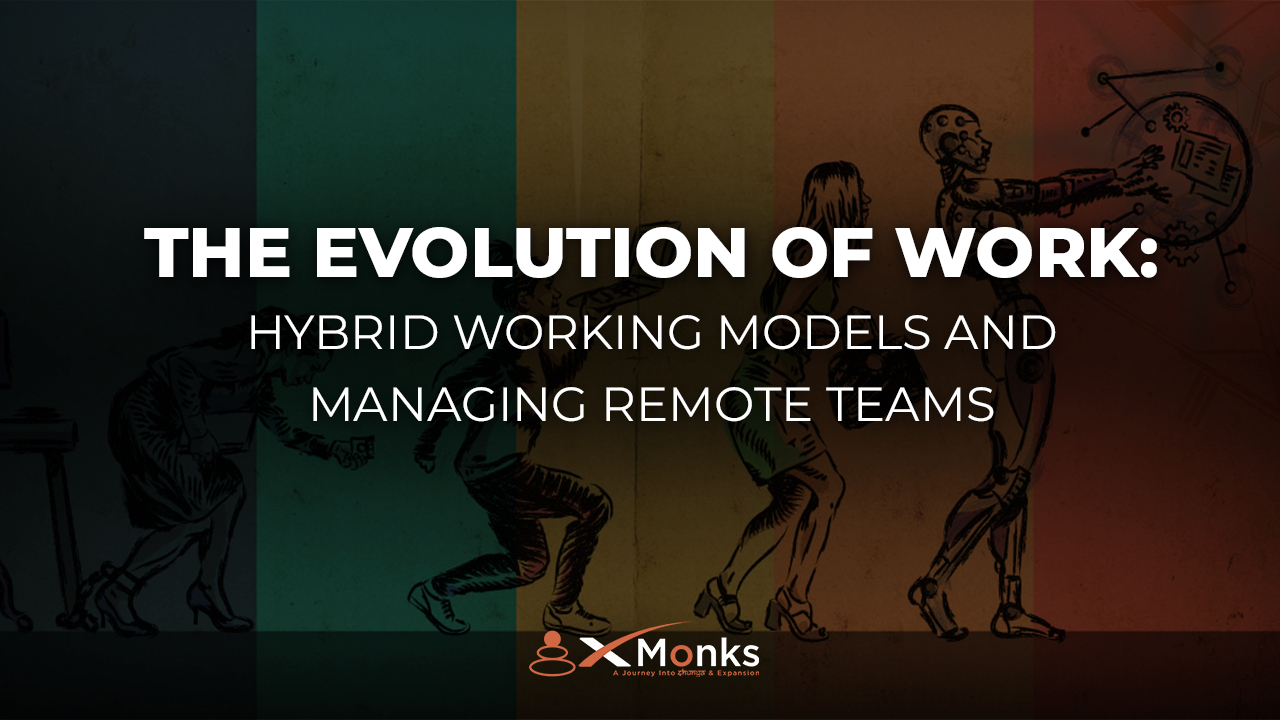
The world of work is not what it once was. The once-familiar confines of the rigid nine-to-five, dictated by clock-ins and office walls, have faded into a realm of flexibility and autonomy. This seismic shift has been driven by the rise of the hybrid working model—a harmonious blend of structure and freedom that adapts to the diverse needs of today’s workforce. The hybrid working model has not just redefined the workplace; it has reimagined how we perceive work itself.
Gone are the days when productivity was measured solely by physical presence. Instead, the hybrid working model champions outcomes, creativity, and balance. It recognises that work happens just as effectively over a morning coffee in a cozy home corner as it does in the hustle of a collaborative meeting room. This fluid rhythm of work empowers employees to bring their best selves to their tasks, fostering a culture of trust, innovation, and mutual respect.
However, this modern-day dance between the physical and virtual is not without its challenges. Managing remote teams under this paradigm has become both an art and a science—an intricate choreography of empathy and strategy. Leaders must balance the tangible needs of in-office collaboration with the intangible threads of remote connection, weaving a fabric where every individual feels seen, heard, and valued.
But why does this hybrid cadence resonate so deeply, becoming the centrepiece of boardroom strategies and watercooler conversations? Its allure lies in its promise—a future of work that honours individuality while maintaining collective goals. It addresses the universal yearning for flexibility without sacrificing the synergy that emerges from shared efforts.
The hybrid working model is more than a trend; it is a testament to the evolving human spirit—one that seeks balance, purpose, and a deeper connection to work. As we navigate this transformative wave, the hybrid working model holds the potential to not only redefine how we work but also how we live and thrive.
Understanding the Hybrid Working Model
What is a Hybrid Working Model?
The hybrid working model is a dynamic blend of remote teams and in-office work. Employees enjoy the flexibility to choose their workspace—be it the comfort of home or the collaborative buzz of the office. It is not just about splitting time; it’s about optimising productivity and well-being.
Key Components of the Hybrid Model
The hybrid working model stands as a testament to flexibility in motion—a delicate dance between structure and freedom. At its core, it’s a system that merges the best of in-office collaboration with the convenience of remote work. But what makes this model thrive? Let’s unpack its essential components.
Flexibility: The Heartbeat of Hybrid Work
Flexibility lies at the heart of the hybrid working model, empowering employees to choose when and where they work best. This adaptability fosters a sense of ownership and trust, allowing individuals to tailor their schedules to align with personal productivity rhythms and responsibilities. Whether it’s starting the day early at home or brainstorming in a bustling office, flexibility fuels creativity and motivation.
Technology Integration: Bridging Worlds
The hybrid working model thrives on the backbone of technology. Video conferencing tools, project management platforms, and instant messaging apps act as bridges connecting dispersed teams. Advanced technologies ensure that workflows remain uninterrupted, communication is seamless, and collaboration transcends physical boundaries.
Organisational Support: A Pillar of Success
For hybrid work to succeed, organisations must provide robust support systems. This includes clear policies outlining hybrid work expectations, ergonomic resources for remote team setups, and opportunities for continuous learning. Without this foundation, the hybrid working model risks becoming a source of confusion rather than a catalyst for growth.
Collaboration Opportunities: Strengthening Team Bonds
Hybrid work doesn’t mean isolation. Well-structured in-office days or virtual team-building activities foster collaboration and maintain the camaraderie essential for cohesive teams. The balance of solo focus time with group synergy ensures both productivity and innovation.
Equity and Inclusion: Levelling the Playing Field
A successful hybrid working model ensures equal opportunities for all employees, regardless of their location. Inclusivity in decision-making, access to resources, and recognition of contributions bridge potential gaps between remote teams and in-office workers.
In essence, the hybrid working model is a carefully orchestrated symphony, harmonising flexibility, technology, support, and inclusivity. When these components align, they create an environment where employees thrive, businesses innovate, and the future of work becomes a little brighter.
The Rising Popularity of Hybrid Work
A Response to the Pandemic’s Challenge
The global pandemic served as a catalyst for hybrid work. When traditional setups were disrupted, businesses found new ways to stay operational. The hybrid working model emerged as a solution that combined safety with efficiency. From reduced commuting stress to increased autonomy, hybrid work brings benefits that resonate with both employers and employees. It boosts morale, supports work-life balance, and attracts top talent.
Challenges of the Hybrid Working Model
Every revolution brings its own set of trials, and the hybrid working model is no exception. As organisations transition into this new era, challenges arise—some expected, others emerging from the uncharted waters of change.
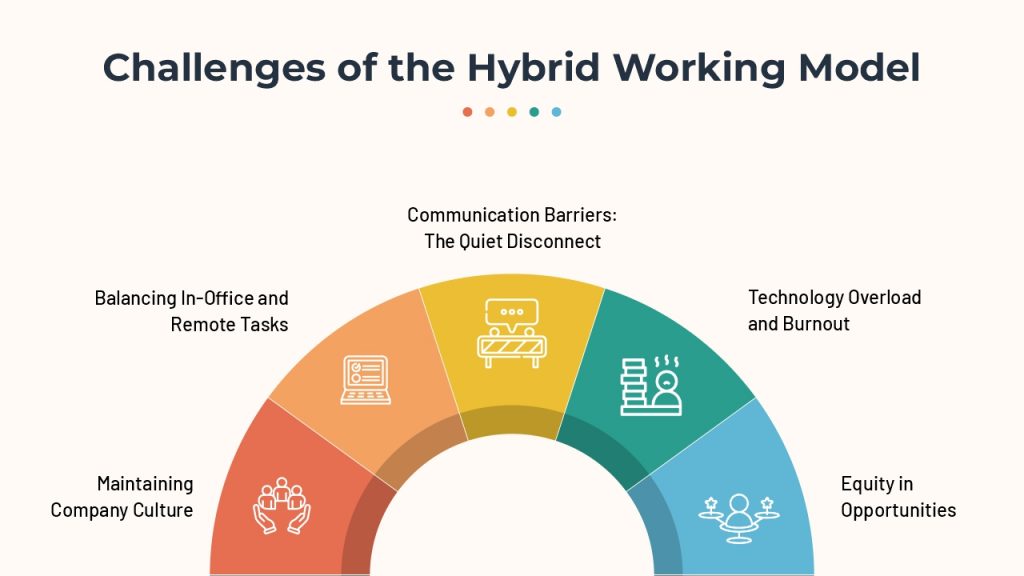
Communication Barriers: The Quiet Disconnect
In a hybrid world, communication often becomes a game of whispers. Remote teams might miss impromptu office discussions, while in-office workers could feel disconnected from virtual updates. Ensuring everyone is heard, informed, and aligned demands intentionality—structured meetings, clear channels, and robust feedback systems.
Balancing In-Office and Remote Tasks
How do you juggle priorities when part of the team is brainstorming in the office, and another is executing tasks remotely? This duality can create a disparity in workloads or even a feeling of imbalance. Leaders must design workflows that integrate both spheres, ensuring neither side feels overburdened or overlooked.
Maintaining Company Culture
Company culture thrives on shared experiences—office traditions, casual conversations, and spontaneous team outings. In hybrid settings, these connections may weaken, leaving employees feeling detached. Organisations must creatively reimagine culture-building activities that resonate both in-person and virtually, weaving the thread of belonging across all spaces.
Technology Overload and Burnout
While technology fuels the hybrid working model, its constant presence can overwhelm employees. The ping of endless notifications, back-to-back virtual meetings, and the blurred line between work and home contribute to digital fatigue. Striking a balance between connectivity and personal time is vital for well-being.
Equity in Opportunities
A significant challenge lies in ensuring equity for remote teams compared to their in-office counterparts. Perceptions of favouritism or unequal opportunities for growth can erode trust. Transparent processes for promotions, feedback, and participation help level the playing field.
The hybrid working model, like a fledgling bird, requires nurturing to soar. These challenges, though daunting, are not insurmountable. With thoughtful strategies and empathetic leadership, businesses can navigate these hurdles, creating a hybrid ecosystem that uplifts everyone under its wings.
Managing Remote Teams in a Hybrid Setting
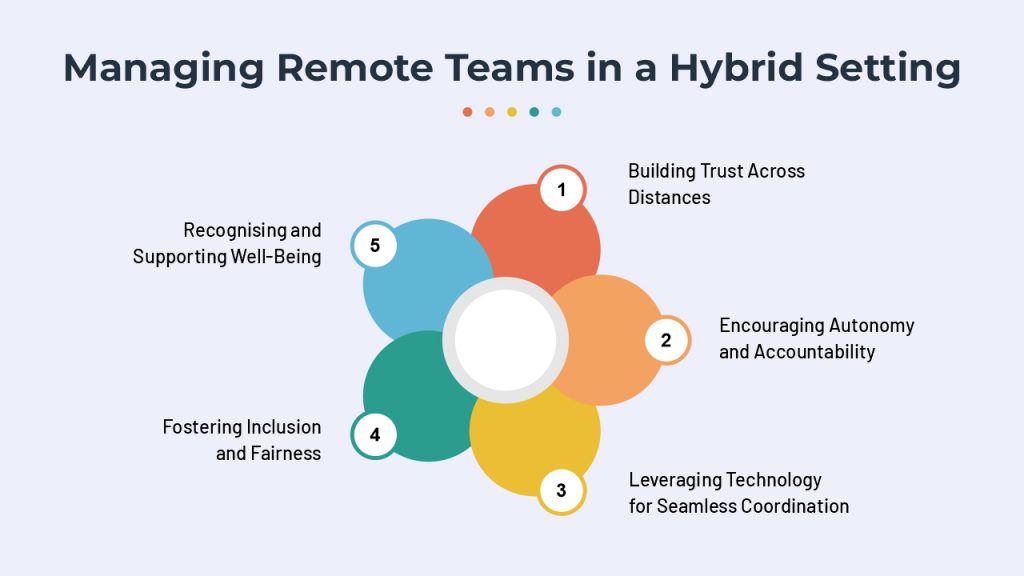
Building Trust Across Distances
Trust is the glue that binds remote teams. Without daily face-to-face interactions, managers must consciously foster an environment of openness and reliability. Transparent communication, regular check-ins, and timely follow-ups build confidence and keep everyone aligned.
Encouraging Autonomy and Accountability
In a hybrid setting, micromanagement is the enemy of progress. Managers need to empower team members by setting clear expectations while giving them the autonomy to achieve goals their way. This balance fosters innovation and ownership, ensuring tasks are handled with care and creativity.
Leveraging Technology for Seamless Coordination
Tools are the silent heroes of remote teams’ management. Platforms like Slack, Zoom, and Trello facilitate seamless communication and task tracking. Yet, relying solely on tools without addressing human needs can lead to disengagement. Managers must balance tech reliance with interpersonal connection.
Fostering Inclusion and Fairness
Hybrid settings can sometimes unintentionally favour in-office workers over the ones working with remote teams. Managers must ensure inclusivity by creating equal opportunities for input, visibility, and recognition. Hosting hybrid meetings where everyone, regardless of location, has a voice helps bridge gaps.
Recognising and Supporting Well-Being
Working with remote teams can blur the line between personal and professional life, leading to burnout. Managers should encourage boundaries, such as signing off at reasonable hours and taking breaks. Offering mental health resources and fostering a supportive environment ensures long-term sustainability.
Managing remote teams in a hybrid setting isn’t about eliminating challenges—it’s about navigating them with empathy and intention. By combining strategic tools with a human-centric approach, leaders can create a cohesive, thriving team that transcends physical boundaries.
Tools and Technologies for Hybrid Success
The hybrid working model owes much of its success to the technologies that support it. These tools act as bridges, connecting dispersed teams, streamlining workflows, and ensuring everyone stays on the same page, no matter where they are.
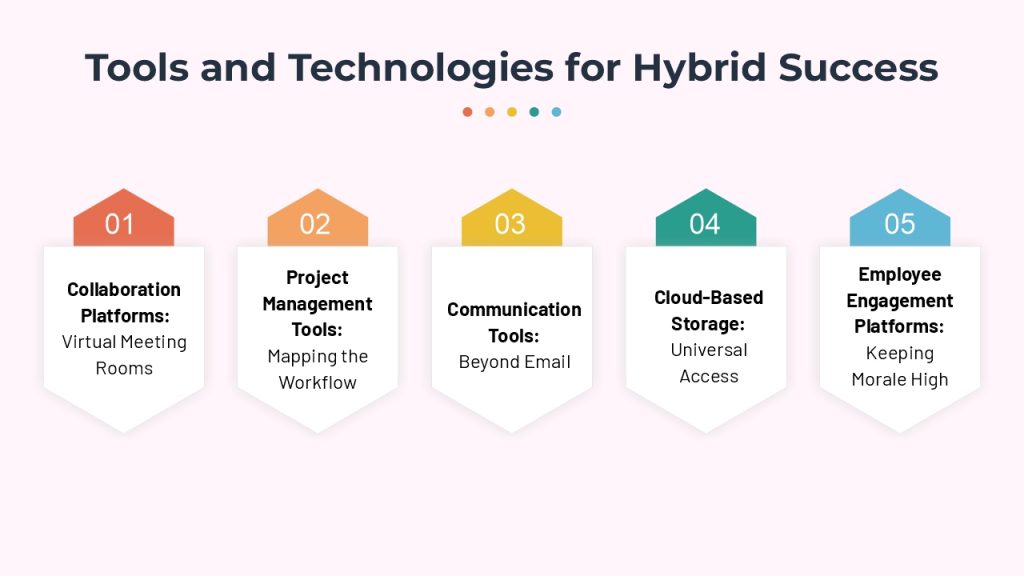
Collaboration Platforms: Virtual Meeting Rooms
Platforms like Microsoft Teams and Zoom transform communication between remote teams, enabling teams to meet, brainstorm, and collaborate as if they were in the same room. Features like screen sharing, breakout rooms, and virtual whiteboards make discussions interactive and engaging.
Project Management Tools: Mapping the Workflow
Applications such as Asana, Trello, and Monday.com are essential for tracking tasks, assigning responsibilities, and monitoring progress. They provide a clear visual representation of what’s done and what’s pending, helping teams stay organised and productive.
Communication Tools: Beyond Email
Instant messaging apps like Slack or Microsoft Teams replace lengthy email threads with real-time conversations. Channels dedicated to specific projects or topics ensure streamlined discussions and fewer misunderstandings.
Cloud-Based Storage: Universal Access
Tools like Google Drive and Dropbox allow hybrid teams to store, share, and edit documents collaboratively. This eliminates version control issues and ensures every team member has access to the latest information.
Platforms like Officevibe or 15Five help managers gauge employee satisfaction and gather feedback. Regular engagement surveys and pulse checks ensure employees feel heard and valued.
Technology is the silent backbone of the hybrid working model, but it’s only as effective as the human connections it supports. By thoughtfully integrating the right tools, businesses can create a seamless, productive, and human-centred hybrid working environment.
Best Practices for Managing Remote Teams
Managing remote teams effectively requires more than just the right tools; it demands intentional leadership and a focus on human connections. Here are some best practices to ensure remote teams thrive in a hybrid world.
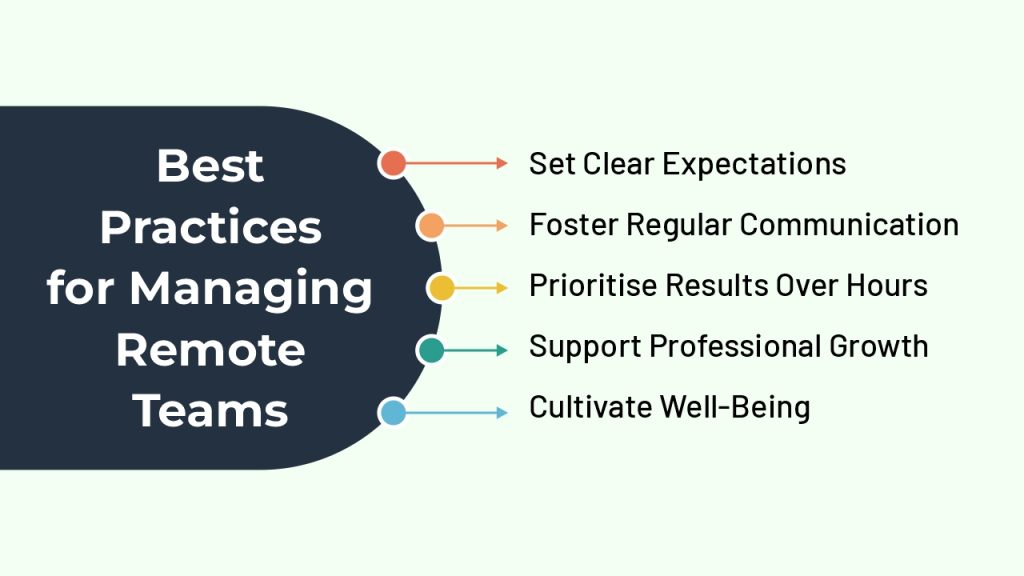
Set Clear Expectations
Clarity is the foundation of productivity. Define goals, deadlines, and roles at the outset of every project. With everyone on the same page, teams can work independently yet cohesively.
Foster Regular Communication
Check-ins aren’t just about updates—they’re about connection. Schedule weekly one-on-ones, team meetings, and casual virtual hangouts to keep the communication flow consistent and open.
Prioritise Results Over Hours
While working with remote teams, the traditional “hours in the office” metric loses meaning. Focus on outcomes rather than time spent at the desk. Recognising results helps foster trust and keeps employees motivated.
Support Professional Growth
Working with remote teams shouldn’t mean stagnation. Offer training, mentorship programs, and access to learning resources to ensure employees continue to grow and feel valued.
Cultivate Well-Being
A team’s health underpins its success. Encourage regular breaks, promote mental health days, and recognise the signs of burnout before they escalate.
Effective management is about guiding, not controlling. By creating an environment of trust, respect, and open communication, leaders can help their remote teams thrive, no matter the distance.
Cultivating a Unified Culture in Hybrid Working Models
A company’s culture is its soul, and in a hybrid world, maintaining it becomes both a challenge and an opportunity. Here’s how organisations can foster unity across physical and digital spaces.
Encourage Inclusive Collaboration
Design meetings and projects where all voices—the ones working with remote teams or the ones in-office—are heard and valued. Hybrid setups should level the playing field, ensuring equal participation and contribution.
Celebrate Achievements Together
Whether it’s a virtual shoutout or an in-person gathering, celebrating successes keeps spirits high. Hybrid models require creative ways to acknowledge milestones and make everyone feel part of the team’s journey.
Create Shared Rituals
From virtual coffee chats to hybrid team-building activities, rituals build familiarity and strengthen bonds. These shared experiences form the glue that keeps teams connected.
Invest in Transparent Communication
A transparent flow of information ensures no one feels left out or in the dark. Regular updates and open forums for feedback build trust and reinforce a shared mission.
Unified culture in hybrid working models isn’t about replicating the past—it’s about reimagining a future where everyone, regardless of location, feels equally invested in the organisation’s success.
The Future of Hybrid Work
The hybrid working model is not just a temporary solution; it’s a glimpse into the future of work. As businesses and employees adapt, this model will continue to evolve, shaped by technology, innovation, and changing societal expectations.
Emerging Trends
- AI Integration: From scheduling meetings to analysing productivity, AI tools will enhance hybrid work experiences.
- Flexible Work Policies: Expect personalised work arrangements tailored to individual needs.
- Digital Nomadism: With hybrid models gaining traction, the concept of “work from anywhere” will expand further.
Challenges Ahead
As promising as the hybrid working model is, it demands ongoing adaptation. Ensuring equity, refining workflows, and addressing technological fatigue will remain critical.
The future of hybrid work is bright yet dynamic. By embracing change and focusing on human needs, organisations can pave the way for a more inclusive, innovative, and flexible working world.
FAQs
Conclusion
The hybrid working model is not just a fleeting trend—it’s a profound revolution, reshaping the very fabric of how we work. By harmoniously marrying flexibility with efficiency, it redefines the boundaries of productivity, collaboration, and individual autonomy. It is more than a response to changing times; it is a bold step into the future, one that prioritises balance and innovation over rigid routines. In this transformative era, managing remote teams is no longer a linear task but a nuanced journey.
For leaders, this journey is one of constant evolution, requiring them to learn, adapt, and lead with empathy. Success in this space is not merely about implementing tools or following processes—it’s about understanding people, fostering trust, and creating environments where every individual, whether in the office or in remote teams, feels connected and valued.
This change is not something to fear or resist but a shift to embrace wholeheartedly. It offers a rare opportunity to reimagine work as more inclusive, sustainable, and aligned with human needs. The hybrid working model is here to stay, and with it comes the promise of a brighter, more adaptable future where organisations and individuals thrive together.

